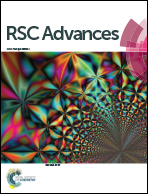A simple and cost effective experimental method for verifying singlet fission in pentacene–C60 solar cells
Abstract
In solar cells, a maximum external quantum efficiency of 100% can be attained if the photocurrent originates from the dissociation of singlet excitons. However, a higher efficiency can be attained through singlet fission (SF), where multiple charge carrier pairs are generated from a single photon, thus increasing the number of excitons and hence the photocurrent generation. The verification of SF is normally difficult and costly. In this study, SF is verified in pentacene by simply measuring the external quantum efficiency (EQE) of a device with a very thick pentacene (indium tin oxide/poly(3,4-ethylenedioxythiophene):poly(4-styrenesulphonate) (PEDOT:PSS) (40 nm)/pentacene (600 nm)/fullerene (40 nm)/tris-8-hydroxy-quinolinato aluminum (8 nm)/Al). A measured EQE of 6.16% at 695 nm is achieved, which is much larger than the maximum calculated EQE (3.45%). The calculation was based on the assumption that all singlet excitons (if SF did not occur) reaching the pentacene–C60 interface contribute to the photocurrent. To account for this discrepancy, only singlet fission to double the number of excitons can be supposed, since a longer singlet diffusion length of 140 nm is not practical in pentacene. Thus, SF in pentacene and the dissociation of triplet excitons at the pentacene–C60 interface have been verified.


 Please wait while we load your content...
Please wait while we load your content...